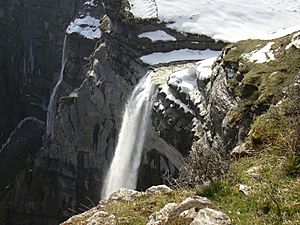Nervión facts for kids
Quick facts for kids Nervión |
|
|---|---|

River Nervion with Zubizuri footbridge.
|
|
| Other name(s) | Basque: Nerbioi |
| Country | Spain |
| Region | Basque Country |
| District | Álava, Biscay |
| City | Bilbao |
| Physical characteristics | |
| Main source | Delika Canyon Sierra Salbada, Álava, Spain 1,000 m (3,300 ft) |
| River mouth | Estuary of Bilbao Bay of Biscay between Portugalete and Getxo, Spain 0 m (0 ft) |
| Length | 72 km (45 mi) |
| Basin features | |
| Basin size | 1,900 km2 (730 sq mi) |
| Tributaries | |
The Nervión River is an important river in Spain. It flows through the city of Bilbao and into the Cantabrian Sea, which is part of the Bay of Biscay. The last part of the river, where it meets the Ibaizabal River, is called the Estuary of Bilbao. In the Basque language, it's called Nerbioi.
Contents
The Nervión River's Journey
The Nervión River is about 72 kilometres (45 mi) long. It starts in the mountains between the Burgos and Alava provinces. The river flows from south to north.
Soon after it starts, the river creates an amazing waterfall. This waterfall is 300 metres (980 ft) tall and is found in the Delika canyon in Alava. It is the biggest waterfall in Spain, reaching 222 meters high!
The river then enters the Biscay province, flowing through the city of Orduña. It goes back into Alava through towns like Amurrio and Llodio. Finally, the river returns to Biscay province and flows into the Cantabrian Sea. It reaches the Bilbao metropolitan area at Ugao-Miraballes.
River Branches and Connections
The Nervión River has several smaller rivers that flow into it. These are called tributaries.
- From the west: The Cadagua and Galindo rivers.
- From the east: The Arratia, Ibaizabal, and Asua rivers.
Some people think the Ibaizabal River is just as important as the Nervión. Because of this, the whole river system is often called Nervión-Ibaizabal. The very last part of the river is simply known as the "Estuary of Bilbao." The total area that collects water for these rivers is about 1,900 square kilometres (730 sq mi).
Why the Name Ibaizabal?
For a long time, the part of the river between the estuary and Basauri (where the Ibaizabal and Nervión join) was known as the Ibaizabal. In the Basque language, Ibaizabal means 'wide river'.
Many old records, from the 11th century all the way to the 20th century, show this name was used. Even famous writers and former mayors of Bilbao, like Miguel de Unamuno, called it the Ibaizabal.
The River's Role in History and Economy
The Nervión valley has always been very important for trade and travel. The Orduña pass, which connects Spain's inner plateau with the Nervión valley, was a key route.
During the Middle Ages, this pass was a natural border. People had to pay tolls (fees) to cross it. Over many centuries, the Nervión valley was a vital path for the region of Biscay. In 1870, the main railway line from Bilbao to the rest of Spain was built right along the river.
Bilbao's Port and Industry
Bilbao grew into a big trading city. Its seaport became the most important on Spain's north coast. The port needed the river to be navigable (deep enough for ships) for its last 15 kilometres (9.3 mi).
An engineer named Evaristo Churruca created a huge plan to fix the river's navigation problems. This made it easier for ships to use the port.
The river also divided the people of Greater Bilbao. On the Left Bank, there were many factories. These factories made steel, smelted metals, and built ships. The workers lived there. On the Right Bank, the factory owners lived in residential areas.
Today, the Nervión River is not as important for the economy as it once was. The part of the river that ships used to use is now being changed. Heavy industries have moved away, allowing new urban areas to be built along the riverbanks.
A Cleaner River: Environmental Improvements
For about 100 years, the Nervión River was very polluted, especially the last 25 kilometres (16 mi). It was so bad that the river had very little oxygen, making it one of the most polluted rivers in the world.
In 1990, local leaders started a big plan to clean up the river. This plan worked! Over 15 years, the river's environment got much better. Now, the Nervión River is clean and full of aquatic life again.
See also
 In Spanish: Nervión para niños
In Spanish: Nervión para niños


